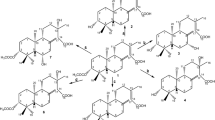Abstract
Microorganisms have been screened for biotransformational activity against diosgenin or its precursor furostanol glycosides obtained from fenugreek seed (Trigonella foenum-graecum). Using diosgenin as the substrate, Cunninghamella elegans and Aspergillus nidulans produced some androstenes when α,α′-dipyridyl was supplemented to the transformation medium. Also, using the glycosides as a substrate, Rhizopus sp. produced diosgenin in >90% yield from the glycoside. The parameters were optimized to increase the yield of the androstenes.




Similar content being viewed by others
References
Abd-Elsalam IS (2000) Physiological, biochemical and dynamical studies on cyclosporine A production. Ph.D. Thesis, Faculty of Science, Tanta University, Tanta, Egypt
Acharya SN, Thomas JE, Basu SK (2008) Fenugreek, an alternative crop for semiarid regions of North America. Crop Sci 48:841–853. doi:10.2135/cropsci2007.09.0519
Akhrem AA, Titov YY (1970) Steroidy i Microorganizmy (Steroids and Microorganisms). Nauka Publishing House, Moscow, pp 89–91
Alvarez G, Pabon A, Carmona J, Blair S (2004) Evaluation of clastogenic potential of the antimalarial plant Solanum nudum. Phyther Res 18:845–848. doi:10.1002/ptr.1534
Chiang C-T, Way T-D, Tsai S-J, Lim J-K (2007) Diosgenin, a naturally occurring steroid, suppress fatty acid synthase expression in HER2-overexpressing breast cancer cells through modulating AKT, MTOR and JNK phosphorylation. FEBS Lett 581:5735–5742. doi:10.1016/j.febslet.2007.11.021
Fernandes P, Cruz A, Angelova B, Pinheiro HM, Cabral JMS (2003) Microbial conversion of steroid compounds: recent development. Enzym Microb Technol 32:688–705. doi:10.1016/S0141-0229(03)00029-2
Hardman R (1969) Extraction of saponins and sapogenins from plants. Trop Sci 11:169
Kondo E, Mitsugi T (1966) Microbial synthesis of 16-keto steroids from steroid sapogenins. J Am Chem Soc 88(20):4737–4738. doi:10.1021/ja00972a046
Liagre B, Vergne-Salle P, Corbiere C, Charissoux JL, Beneytout JL (2004) Diosgenin, a plant steroid, induces apoptosis in human rheumatoid arthritis synoviocytes with cyclooxygenase-2overexpression. Arthritis Res Ther 6:R373–R383. doi:10.1186/ar1199
Nagasawa N, Hashiba H, Watanate N, Bac M, Tamura G, Arima K (1970) Microbial transformation of sterols. Agric Biol Chem Jpn 34:801
Naim N, Naim MA (1985) Mechanism of the enzymatic conversion of progesterone with Trichurus spiralis. Rev Lat Am Microbiol 27:213–217
Oxoid (1982) The oxoid manual of culture media, ingredients and other laboratory services, 5th edn. Oxoid Limited, England
Patil S, Mishra K (1989) Side chain cleavage of some steroid drug precursors by Mycobacterium mutants. Indian J Exp Biol 27(4):374–375
Puri R, Wong TC (1993) Solasodine and diosgenin: 1H and 13C assignments by two-dimensional NMR spectroscopy. Magn Reson Chem 31:278–282. doi:10.1002/mrc.1260310313
Raju J, Patlolla JMR, Swamy MV, Rao CV (2004) Diosgenin, a steroid saponin of Trigonella foenum-graecum (Fenugreek), inhibits azoxymethane-induced aberrant crypt foci formation in F344 rats and induces apoptosis in HT-29 human colon cancer cells. Cancer Epidemiol Biomark α prev 13:1392–1398
Roberts SM, Eddolls JP, Willetts AJ, Atkinson A, Murphy JP (1996) Preparation of androcorticoid steroids. GB patent 2318790
Sahoo S, Das R, Jaim SC (1999) Influence of cholesterol on growth and production of diosgenin and solasodine on Solanum jasminoides and Solanum verbascifolium suspension cultures. J Med Aromat Plant-Sci 21(3):668–671
Sallam LAR, El-Refai AH, El-Kady IA (1969) Thin-layer chromatography of some C21, C19 and C18 steroid. J Gen Appl Microbiol 15:307–315. doi:10.2323/jgam.15.307
Sallam LAR, El-Refai AH, Naim N, El-Minofi HA (1987) Side chain degradation of sterols by some local microorganisms. Egypt J Microbiol 22(2):339–348
Sallam LAR, El-Abyad MS, El-Refai AH, El-Menofi HA, Adham NZ (1995) Bioconversion of 19-nortestosterone by Rhodococcus sp. DSM92–344.1: optimization of transformation parameters. Process Biochem 30(1):25–34
Saunders RP, Cheetham PSJ, Hardman R (1985) The use of a hydrophobic resin as a product reservoir in steroid transformations. Biotechnol Bioeng 27:825–831. doi:10.1002/bit.260270611
Saunders RP, Cheetham PSJ, Hardman R (1986) Microbial transformation of crude fenugreek steroids. Enzym Microb Technol 8:549–550. doi:10.1016/0141-0229(86)90040-2
Schreiber K (1970) Recent advances in the chemistry of plant steroids. Pure Appl Chem 21(2):131–152. doi:10.1351/pac197021020131
Shukla A, Patil S, Bharti S (1992) Microbial conversion of solasodine to 1-androstene-3,17-dione (AD), a key intermediate for androgen synthesis. Lett Appl Microbiol 15:86–88. doi:10.1111/j.1472-765X.1992.tb00732.x
Slocum SA, Studebaker JF (1975) Analysis of enzymatic steroid conversions by HPLC. Anal Biochem 68:242–247. doi:10.1016/0003-2697(75)90701-0
Trouillas P, Corbiere C, Liagre B, Duroux JL, Beneytout JL (2005) Structure–Function relationship for saponin effects on cell cycle arrest and apoptosis in the human 1547 osteosarcoma cell: a molecular modelling approach of natural molecules structurally close to diosgenin. Bioorg Med Chem 13:1141–1149. doi:10.1016/j.bmc.2004.11.031
Wang F-Q, Li B, Wang W, Zhang C-G, Wei D-Z (2007) Biotransformation of diosgenin to nuatigenin-type steroid by a newly isolated strain, Streptomyces virginiae IBL-14. Appl Microbiol Biotechnol 77:771–777. doi:10.1007/s00253-007-1216-1
Weber A, Kennekke M, Klages U, Nickisch K, Rhode R (1995) Process for the production of 17-oxosteroids via the fermentative oxidation of 17β-hydroxysteroids by Mycobacterium. US patent 5, 472, 854
Author information
Authors and Affiliations
Corresponding author
Rights and permissions
About this article
Cite this article
Adham, N.Z., Zaki, R.A. & Naim, N. Microbial transformation of diosgenin and its precursor furostanol glycosides. World J Microbiol Biotechnol 25, 481–487 (2009). https://doi.org/10.1007/s11274-008-9913-1
Received:
Accepted:
Published:
Issue Date:
DOI: https://doi.org/10.1007/s11274-008-9913-1




